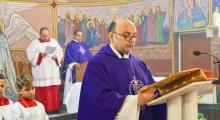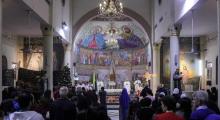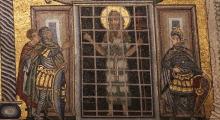Issued by the Catholic Center for Studies and Media - Jordan. Editor-in-chief Fr. Rif'at Bader - موقع أبونا abouna.org

On Tuesday, March 21, 2023, on the Solemnity of the Transitus of Saint Benedict, the Dormition Abbey consecrated its new altar. The Mass was presided over by Cardinal Rainer Maria Woelki, president of DVHL, and was concelebrated by Mgr William Shomali, General Vicar, Mgr Giacinto-Boulos Marcuzzo, bishop emeritus, Abbot Nikodemus C. Schnabel, osb, the newly elected abbot of the Dormition Abbey and Tabgha, as well as several other bishops and priests representing other churches in Jerusalem.
“It is a joyful day for us here in Jerusalem, as we dedicate this newly restored altar after two years of works. The Dormition Abbey is a place of prayer amid a city yearning to find its vocation of peace. The prayers of the Benedictine monks who live on Mount Zion play a great role in accomplishing this peace. We know this from ‘the prayer for the peace of Jerusalem’ found in Psalm 122, verse 7: ‘May those who love you be secure. May there be peace within your walls and security within your citadels’. These words hold a lot of meaning as we recite them from this place,” said Mgr Shomali, who concelebrated the celebration on behalf of His Beatitude Pierbattista Pizzaballa, Latin Patriarch of Jerusalem.
A representative of the German Embassy in Tel Aviv, and representatives of multiple German institutions in the Holy Land attended the celebration, as well as a great number of faithful.
Mgr Woelki presided over the Rite of Consecration, which is done according to the Roman Pontifical Book. The rite includes several elements: Holy water, relics of Saints, Chrism oil, and incents. The consecration invokes the Holy Spirit to come and dwell within the altar, making it Sacred and worthy to receive the Blood of Jesus. “The altar becomes a representation of God’s presence in our midst,” said Mgr Woelki.
The rite first began with the Litany of Saints, as the Cardinal went around the altar sprinkling it with Holy water. Then, he placed the relics of the apostles, a handwritten Bible, and the Rule of St. Benedict inside the new altar, which was sealed with a mosaic, created by a benefactor of the Dormition. This stage of the consecration refers to the liturgy as it is presented in the book of Revelation: “I [John] saw under the altar the souls of those who had been slain for the word of God.”
Then, after the top of the altar was anointed with sacred Chrism, incense was placed and burnt on the five crosses, which were engraved in the corners and center of the altar, representing the five wounds Jesus bore on the cross.
During the burning of the incense, the Cologne Cathedral Choir sang an antiphon from the Book of Revelation: “Another angel, who had a golden censer, came and stood at the altar. He was given much incense to offer, with the prayers of all God’s people, on the golden altar in front of the throne,” followed by the words: “Come, Holy Spirit, fill the hearts of Thy faithful, and enkindle in them the fire of Thy love.”
Finally, Mgr Woelki recited the words of the prayer of consecration that emphasizes the importance of the altar in the history of salvation.
In his homily, Mgr Woelki compared the consecration of the altar to the consecration of a child through baptism, communion and confirmation, saying: “The same way Christians get sanctified and become part of a new creation by receiving these sacraments, the altar gets sanctified by Chrism oil and holy water.”
During the celebration, Abbot Nikodemus expressed his gratitude to the German federal government for its support of the abbey’s ongoing renovation and spoke about the celebration, saying: “The altar is the center of every church. With the consecration of the new altar, the center of our church and monastery is now solemnly restored, not only provisionally, but permanently. We as a monastic community say yes to this center that makes Christ present in our midst.”
The Dormition Church is a German Catholic Church, given in 1910 to the German Kaiser Wilhelm II. Due to its round shape, the church building is distinct from other churches in Jerusalem, which are usually rectangular. The design of the church incorporates elements from East and West. The church was built on the site in which Mary, mother of Jesus, fell into an eternal sleep, hence the name “Dormition”.







